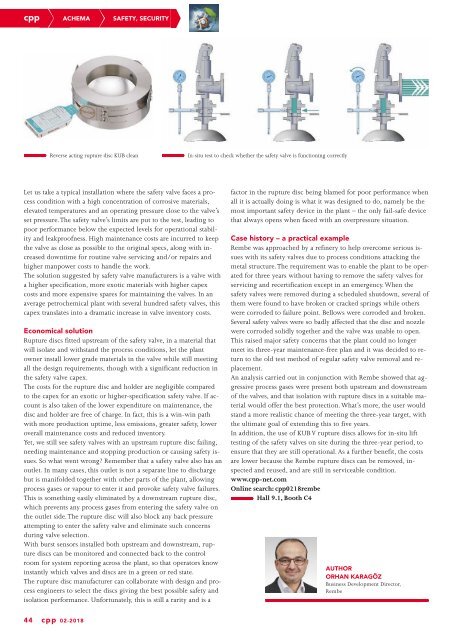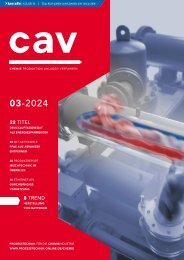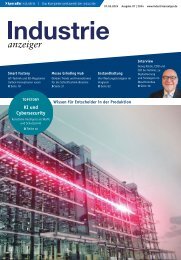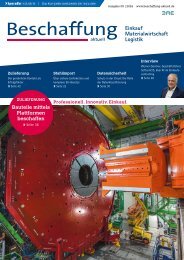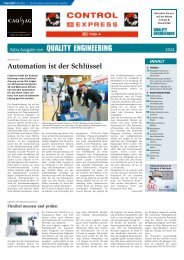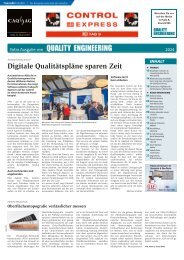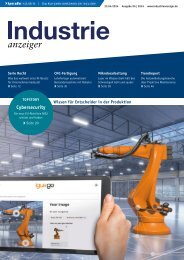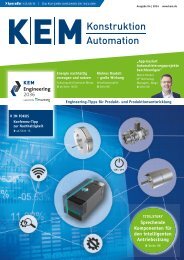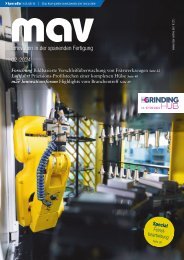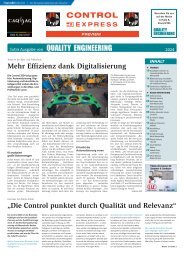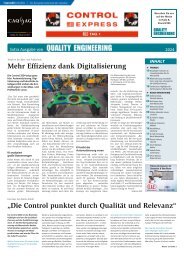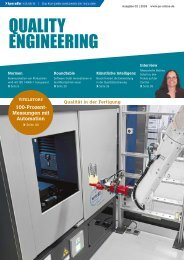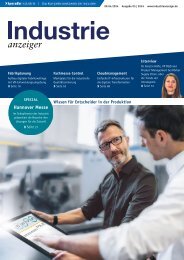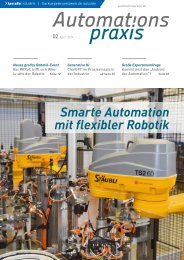cpp - Process technology for the chemical industry 02.2018
Create successful ePaper yourself
Turn your PDF publications into a flip-book with our unique Google optimized e-Paper software.
<strong>cpp</strong> ACHEMA SAFETY, SECURITY<br />
Reverse acting rupture disc KUB clean<br />
In-situ test to check whe<strong>the</strong>r <strong>the</strong> safety valve is functioning correctly<br />
Let us take a typical installation where <strong>the</strong> safety valve faces a process<br />
condition with a high concentration of corrosive materials,<br />
elevated temperatures and an operating pressure close to <strong>the</strong> valve’s<br />
set pressure. The safety valve’s limits are put to <strong>the</strong> test, leading to<br />
poor per<strong>for</strong>mance below <strong>the</strong> expected levels <strong>for</strong> operational stability<br />
and leakproofness. High maintenance costs are incurred to keep<br />
<strong>the</strong> valve as close as possible to <strong>the</strong> original specs, along with increased<br />
downtime <strong>for</strong> routine valve servicing and/or repairs and<br />
higher manpower costs to handle <strong>the</strong> work.<br />
The solution suggested by safety valve manufacturers is a valve with<br />
a higher specification, more exotic materials with higher capex<br />
costs and more expensive spares <strong>for</strong> maintaining <strong>the</strong> valves. In an<br />
average petro<strong>chemical</strong> plant with several hundred safety valves, this<br />
capex translates into a dramatic increase in valve inventory costs.<br />
Economical solution<br />
Rupture discs fitted upstream of <strong>the</strong> safety valve, in a material that<br />
will isolate and withstand <strong>the</strong> process conditions, let <strong>the</strong> plant<br />
owner install lower grade materials in <strong>the</strong> valve while still meeting<br />
all <strong>the</strong> design requirements, though with a significant reduction in<br />
<strong>the</strong> safety valve capex.<br />
The costs <strong>for</strong> <strong>the</strong> rupture disc and holder are negligible compared<br />
to <strong>the</strong> capex <strong>for</strong> an exotic or higher-specification safety valve. If account<br />
is also taken of <strong>the</strong> lower expenditure on maintenance, <strong>the</strong><br />
disc and holder are free of charge. In fact, this is a win-win path<br />
with more production uptime, less emissions, greater safety, lower<br />
overall maintenance costs and reduced inventory.<br />
Yet, we still see safety valves with an upstream rupture disc failing,<br />
needing maintenance and stopping production or causing safety issues.<br />
So what went wrong? Remember that a safety valve also has an<br />
outlet. In many cases, this outlet is not a separate line to discharge<br />
but is manifolded toge<strong>the</strong>r with o<strong>the</strong>r parts of <strong>the</strong> plant, allowing<br />
process gases or vapour to enter it and provoke safety valve failures.<br />
This is something easily eliminated by a downstream rupture disc,<br />
which prevents any process gases from entering <strong>the</strong> safety valve on<br />
<strong>the</strong> outlet side. The rupture disc will also block any back pressure<br />
attempting to enter <strong>the</strong> safety valve and eliminate such concerns<br />
during valve selection.<br />
With burst sensors installed both upstream and downstream, rupture<br />
discs can be monitored and connected back to <strong>the</strong> control<br />
room <strong>for</strong> system reporting across <strong>the</strong> plant, so that operators know<br />
instantly which valves and discs are in a green or red state.<br />
The rupture disc manufacturer can collaborate with design and process<br />
engineers to select <strong>the</strong> discs giving <strong>the</strong> best possible safety and<br />
isolation per<strong>for</strong>mance. Un<strong>for</strong>tunately, this is still a rarity and is a<br />
factor in <strong>the</strong> rupture disc being blamed <strong>for</strong> poor per<strong>for</strong>mance when<br />
all it is actually doing is what it was designed to do, namely be <strong>the</strong><br />
most important safety device in <strong>the</strong> plant – <strong>the</strong> only fail-safe device<br />
that always opens when faced with an overpressure situation.<br />
Case history – a practical example<br />
Rembe was approached by a refinery to help overcome serious issues<br />
with its safety valves due to process conditions attacking <strong>the</strong><br />
metal structure. The requirement was to enable <strong>the</strong> plant to be operated<br />
<strong>for</strong> three years without having to remove <strong>the</strong> safety valves <strong>for</strong><br />
servicing and recertification except in an emergency. When <strong>the</strong><br />
safety valves were removed during a scheduled shutdown, several of<br />
<strong>the</strong>m were found to have broken or cracked springs while o<strong>the</strong>rs<br />
were corroded to failure point. Bellows were corroded and broken.<br />
Several safety valves were so badly affected that <strong>the</strong> disc and nozzle<br />
were corroded solidly toge<strong>the</strong>r and <strong>the</strong> valve was unable to open.<br />
This raised major safety concerns that <strong>the</strong> plant could no longer<br />
meet its three-year maintenance-free plan and it was decided to return<br />
to <strong>the</strong> old test method of regular safety valve removal and replacement.<br />
An analysis carried out in conjunction with Rembe showed that aggressive<br />
process gases were present both upstream and downstream<br />
of <strong>the</strong> valves, and that isolation with rupture discs in a suitable material<br />
would offer <strong>the</strong> best protection. What’s more, <strong>the</strong> user would<br />
stand a more realistic chance of meeting <strong>the</strong> three-year target, with<br />
<strong>the</strong> ultimate goal of extending this to five years.<br />
In addition, <strong>the</strong> use of KUB V rupture discs allows <strong>for</strong> in-situ lift<br />
testing of <strong>the</strong> safety valves on site during <strong>the</strong> three-year period, to<br />
ensure that <strong>the</strong>y are still operational. As a fur<strong>the</strong>r benefit, <strong>the</strong> costs<br />
are lower because <strong>the</strong> Rembe rupture discs can be removed, inspected<br />
and reused, and are still in serviceable condition.<br />
www.<strong>cpp</strong>-net.com<br />
Online search: <strong>cpp</strong>0218rembe<br />
Hall 9.1, Booth C4<br />
AUTHOR:<br />
ORHAN KARAGÖZ<br />
Business Development Director,<br />
Rembe<br />
44 <strong>cpp</strong> 02-2018


